The Google Nexus 7 Review
by Anand Lal Shimpi & Brian Klug on July 26, 2012 11:35 AM ESTThe Display
In this new age of high resolution panels with small dimensions, the goal seems to be to just get the display out of the way. You shouldn't notice the display, it should just quietly do its job and make you believe that what you're looking at is real. When viewed with this critical eye, very few displays do their job well.
The Nexus 7's display is somewhere between good and perfection. It's not on the latter end of the spectrum, but it's great for $199. Black levels are good, and max brightness is more than enough for indoor use, although you'll have problems outdoors if it's too sunny.
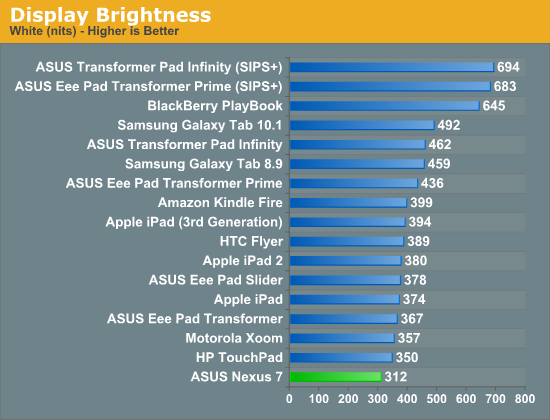
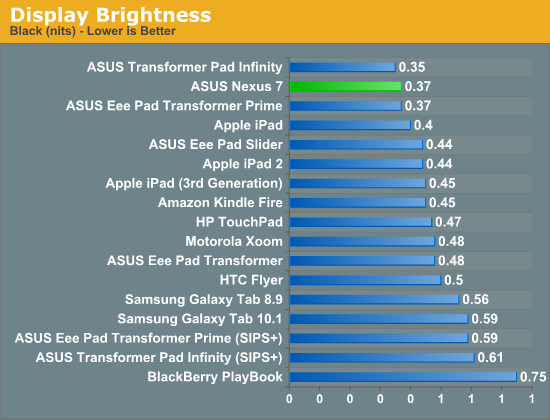

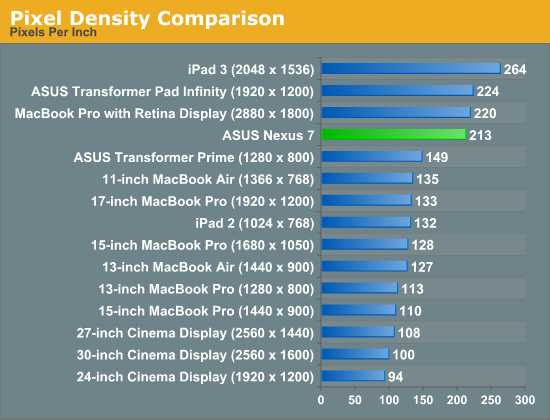
The resolution is high enough that neither Brian nor I were able to identify individual pixels at our normal viewing distances. Images do look better on the new iPad however (not a resolution but rather a panel advantage).
The other interesting aspect of the Nexus 7 is that it is a relatively new and somewhat interesting display form factor. 213 pixels per inch in a 7 inch display is unique for an Android tablet, and puts the Nexus 7 in the "tvdpi" screen density category for Android, 600 x 961 dp (that's dp - density independent pixels, relative to 160 ppi).
The end result is that some applications get a scaled down version of the 10" form factor Android 4.x UI, others don't. Some pages use the phone layout (for example the settings page, play store, and the notifications shade), others use the tablet two pane layout (for example Gmail) due to the 600dp width of the Nexus 7. That is to say it isn't totally correct to say that the UI on the Nexus 7 is a larger, scaled version of the phone UI, but something of an intermediary between the traditional 10" tablet version, and the phone version depending on what the break point is (in dps) for the particular app.
The other interesting note is that because 'tvdpi' isn't a primary display density for Android developers to build assets against, most often bitmaps get scaled down from the hdpi asset. In most places there isn't much of a noticeable softening of the edges, but I'll admit there are a few places where it's obvious bitmaps have been decimated and look a bit soft. Luckily, the pixel density of the display itself is high enough to mask most of this, but it isn't always perfect.
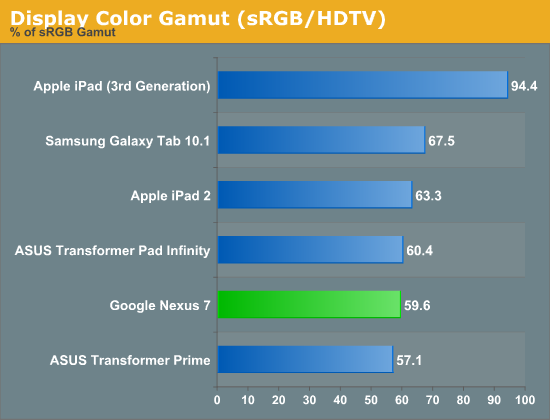
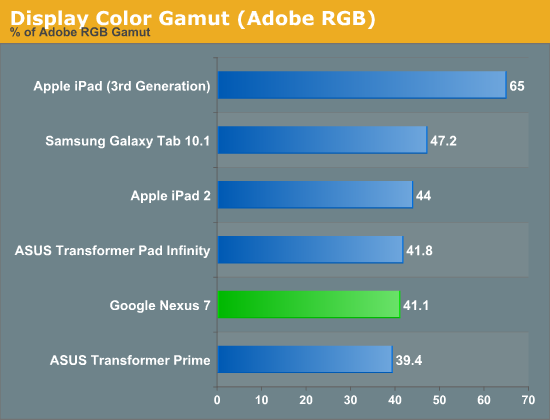
The Nexus 7's IPS panel offers great viewing angles, something that's simply a requirement for any device whose primary interface revolves around the display. Color accuracy is simply middle of the road, but I don't expect many users to do a lot of professional photo editing on the Nexus 7 so I'm not sure how much this actually matters.


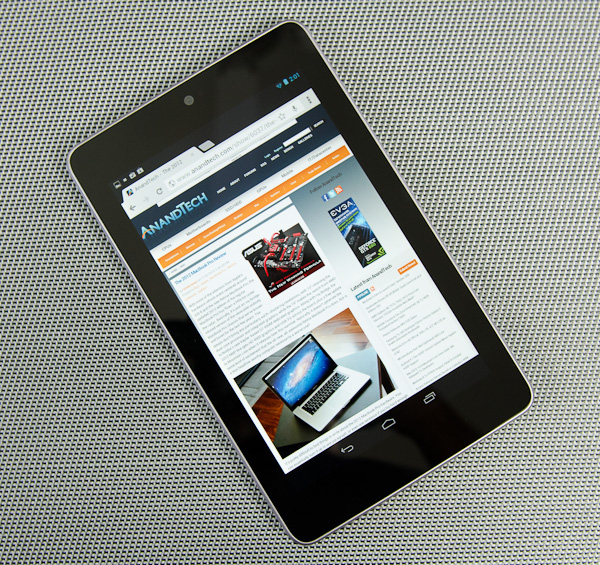








118 Comments
View All Comments
bennyg - Tuesday, July 31, 2012 - link
Maybe Google saw the gobs of cash Apple make from crazy high markups on storage once you lock your userbase out of choice in the matter.I'm glad Android has internal competition in the smartphone area for this reason. Time will tell if my decision to opt for 8gb is a bad one, but really since it has no camera I'll only ever run out of space when copying something onto it which puts me firmly in control and I'm fine with that.
fmcjw - Thursday, August 2, 2012 - link
Applaud mentioning that Google is charging $50 for $4 of NAND. Wondering why Apple is not reviewed with such analytic words.Brian's and Anand's writing are the only knowledgeable content on this site, with the rest being filler material. That said, still not lowering my ad-block on Anandtech, since Anand drools praise on Apple products, throwing money at a 117b dollar rich company which is:
monopolistic (in behavior if not absolute terms),
dictatorial (imposing business-driven restrictions on technology), and
unimaginative (riding wave of state of the art tech manufacturing, always at the cusp of killing established business models with many players for its sole profit)
IMO Anand is single minded and is narrow in his views. Yes, he appreciates "the best" tech, but is eager to distance himself from less obvious virtues and legacy concerns. It's also apparent he feels no responsibility and vision towards diversity, choice, and the underdogs in the industry, preferring the elite wherever possible, Intel over AMD, Apple over the rest. By being "objective" and focused on what he deems palatable and suitable, he is no different from Monsanto: technology in a vacuum, umbilical cord as leash.
And once he is happily on Apple's leash, you can see how his values get whipped around.
NoNeedForMonkeys - Saturday, August 4, 2012 - link
I have not had to pay for cloud storage. The N7 is a play store front-end for media streaming. Google is heavily pushing streaming services over local storage.The USB port on this thing is compliant to MHL specs and future software should be able to enable HDMI adapters, but the software is not allowing full functionality yet. The USB port is also hardware compliant with USB OTG, it is just not enabled in software.
EnzoFX - Thursday, July 26, 2012 - link
What is there for a reviewer to talk about besides simply stating it doesn't have one? Which they all do. It doesn't have one, this you know already, you're either ok with it, or it's not for you. They know what they did and they still chose to do it. Get over it?Sined - Thursday, July 26, 2012 - link
To be honest, it's a bit unfair to knock on any Android Device for the lack of MicroSD card storage.Dan Morrill of Google's Android Team explains why:
http://www.androidpolice.com/2011/11/18/impromptu-...
It has to do with how USB Mass Storage works and how Apps and Media mingle in the same storage when dealing with internal storage only.
Ideally, ALL Android devices should have SD Cards but Android hasn't matured in that department enough to have them on the Nexus Line.
Death666Angel - Thursday, July 26, 2012 - link
As I read that, he says they don't have a microSD slot because it would make settings up things harder ("where does the camera save pictures, where should that app be installed?"). I am glad that I only have android devices with microSD slots. I don't agree with the dumbing down of options he wants. If I wanted that, I'd go with iOS. :-) Looks like I won't get any Nexus device any time soon.leexgx - Saturday, July 28, 2012 - link
Samsung seem to do it right, the as the main 16gb mem (for example) is split norm 2gb and 12gb (that shows as an SD card)and ones with an SD card slot are shown as an second SD card slot
robinthakur - Tuesday, July 31, 2012 - link
Yes, a shame that the phone slows down so much when you start filling up the internal memory though, its like it doesn't ring-fence enough for the OS.Impulses - Friday, July 27, 2012 - link
Yeah, I don't think they've omitted the expandable storage slots for any one particular reason but more a combination of them... Usability + cost cutting + working out some technical aspects. Still, it's a compromise and he admits as much.I think the best compromise is what HTC did with the EVO LTE and what I believe Samsung did with the SGS3: internal storage is all MTP so apps, media, and the OS can share the space without strict partitions and you don't need to unmount from theOS to sync content, and the external storage is still good old UMS so you can work around MTP sync issues and/or have expandable storage for media.
It's still a compromise tho, what Morrill states is true, not all apps are built to scan external storage or handle the disconnect of it elegantly. The OS handles it just fine in the case of music/photos IMO (since there's a media scanner) but other stuff can be hit or miss.
Shadowmaster625 - Thursday, July 26, 2012 - link
Anyone who buys a device like this with no storage option is just a fool. Let it burn.